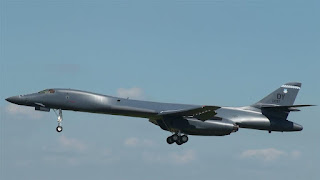The US has “pretty much exhausted all the things that we can do at the [UN] Security Council at this point,” Nikki Haley, US Ambassador to the UN, said Sunday regarding North Korea’s continued missile tests, adding she would be “perfectly happy” to pass the situation onto Pentagon chief James Mattis who has “plenty of military options.”
Haley’s warning comes in stark contrast made by former US state department officials who say there’s still room to engage North Korea diplomatically. Pyongyang’s military has conducted three ballistic missile tests since US President Donald Trump told reporters the country would be met with “fire and fury and, frankly, power, the likes of which the world has never seen before” if it kept up threats to the US and its allies.
Four US Marine Corps F-35 joint strike fighters and two US Air Force B-1B Lancer strategic bombers zipped through South Korean airspace with South Korean and Japanese fighters in a “sequenced bilateral show of force” on September 17 in retaliation to North Korea’s September 14 ballistic missile test, according to a US Pacific Command statement.
While there has been a great deal of media attention surrounding the Lancer’s technical ability to carry nuclear weapons, the US military’s fastest bombers are inspected annually by Russian experts to ensure all B-1Bs are compliant with the Cold-War era Strategic Arms Reduction Treaty, which bars them from carry nukes. Defense officials told Military.com in July the plane “will never be a nuclear-capable bomber again.”
[sputniknews.com]
18/9/17
Haley’s warning comes in stark contrast made by former US state department officials who say there’s still room to engage North Korea diplomatically. Pyongyang’s military has conducted three ballistic missile tests since US President Donald Trump told reporters the country would be met with “fire and fury and, frankly, power, the likes of which the world has never seen before” if it kept up threats to the US and its allies.
Four US Marine Corps F-35 joint strike fighters and two US Air Force B-1B Lancer strategic bombers zipped through South Korean airspace with South Korean and Japanese fighters in a “sequenced bilateral show of force” on September 17 in retaliation to North Korea’s September 14 ballistic missile test, according to a US Pacific Command statement.
While there has been a great deal of media attention surrounding the Lancer’s technical ability to carry nuclear weapons, the US military’s fastest bombers are inspected annually by Russian experts to ensure all B-1Bs are compliant with the Cold-War era Strategic Arms Reduction Treaty, which bars them from carry nukes. Defense officials told Military.com in July the plane “will never be a nuclear-capable bomber again.”
[sputniknews.com]
18/9/17

No comments:
Post a Comment